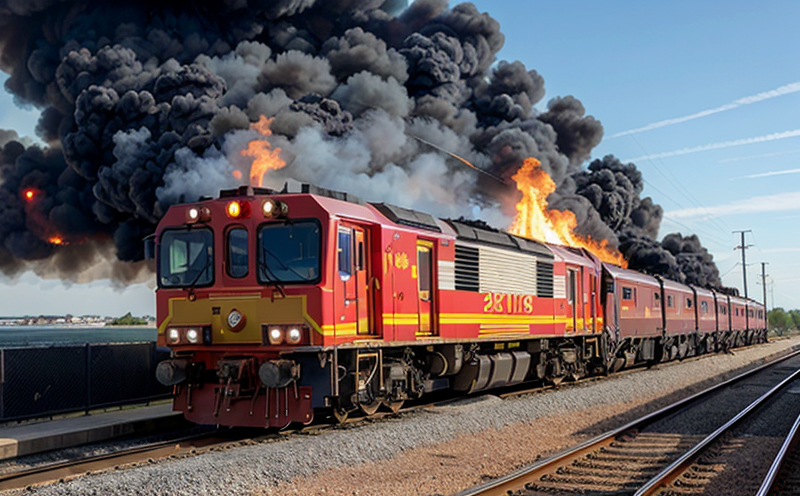ISO 5659-2 Smoke Generation Testing for Marine & Railway Materials
The ISO 5659-2 standard is specifically designed to assess smoke generation from materials used in marine and railway environments. This critical test ensures that the products meet stringent safety standards, thereby protecting personnel and structures from the risks associated with fire. The test measures the amount of smoke produced by a material when it undergoes combustion under controlled conditions. This information is vital for ensuring that materials used in these sectors comply with international regulations.
The methodology involves subjecting specimens to a standard heat source until they reach ignition temperature and then measuring the volume, opacity, and other characteristics of the generated smoke. Compliance with this test not only ensures compliance with fire safety standards but also enhances overall product quality by identifying potential hazards early in the development process. This service is particularly important for manufacturers and suppliers who need to demonstrate their products' adherence to global standards.
The significance of ISO 5659-2 testing extends beyond mere compliance; it contributes significantly to improving public safety, reducing risks associated with fire incidents, and enhancing the overall reliability of materials in marine and railway applications. By addressing smoke generation early on, manufacturers can make necessary adjustments during development stages, ensuring that final products are not only safe but also meet stringent regulatory requirements.
Smoke generated from materials can pose serious threats if it is not controlled properly. In environments like ships and trains, where confined spaces abound, the spread of fire through smoke channels can exacerbate an emergency situation. Therefore, understanding how different materials behave under similar conditions helps in selecting appropriate alternatives that minimize these risks.
The importance of this test cannot be overstated given its role in safeguarding lives at sea or on land. It plays a crucial part in ensuring that the products used within such critical sectors are reliable and safe. By conducting rigorous smoke generation tests, we contribute towards building safer environments for all stakeholders involved - from manufacturers to end-users.
Why It Matters
The safety of individuals working in marine and railway settings is paramount, and ensuring that the materials used meet stringent fire safety standards is essential. Smoke generation tests help identify potential hazards before they become significant issues during actual use. This early detection allows manufacturers to make necessary modifications during product development stages, resulting in safer end products.
Compliance with international standards such as ISO 5659-2 ensures that the materials used are not only safe but also reliable across various applications within the marine and railway sectors. By adhering to these guidelines, organizations can enhance their reputation for producing high-quality goods that meet global expectations while simultaneously promoting public safety.
The results from smoke generation tests provide valuable insights into material behavior during combustion which could otherwise go unnoticed until after deployment. This information is crucial in identifying areas where improvements are needed and helps guide future research efforts aimed at developing more advanced fire-resistant materials.
Ultimately, compliance with ISO 5659-2 standards contributes to creating safer working conditions for everyone involved while also protecting the integrity of structures against potential damage caused by fires. It is an indispensable tool in maintaining high levels of safety and reliability throughout both sectors.
Scope and Methodology
| Aspect | Description |
|---|---|
| Test Specimen Preparation | The test specimens should be representative of the actual materials used in marine or railway applications. They must be prepared according to specified dimensions and weight. |
| Combustion Conditions | The combustion chamber is maintained at a constant temperature, typically set between 750°C and 950°C depending on the specific requirements of the test specimen. |
| Smoke Measurement | Sensors within the combustion chamber measure various parameters including volume, opacity, and particle size distribution of the generated smoke. |
| Data Collection & Analysis | All data collected during the test is analyzed to determine whether the specimen meets the acceptance criteria specified in ISO 5659-2. |
The process begins with careful preparation of representative specimens that mimic real-world usage conditions. These specimens are then subjected to controlled combustion scenarios where their smoke generation characteristics can be accurately measured and analyzed. The parameters recorded include the volume, opacity, and particle size distribution of the emitted smoke.
Following successful completion of each test run, detailed reports summarizing all findings are generated. These comprehensive documents provide a clear picture of how well individual specimens perform under given conditions. They also highlight any areas where improvements may be necessary based on observed results.
Eurolab Advantages
At Eurolab, we pride ourselves on providing top-notch services tailored to meet the specific needs of our clients in the marine and railway sectors. Our expertise lies in delivering accurate, reliable testing that ensures compliance with international standards like ISO 5659-2.
We employ state-of-the-art equipment and highly trained professionals who understand both theoretical aspects and practical applications of fire safety testing. With years of experience behind us, we have built a reputation for excellence among our clients across various industries.
Our commitment to quality extends beyond just performing the tests; it includes offering valuable insights into best practices for material selection and design considerations that enhance overall product performance and longevity.
In addition to testing services, Eurolab offers consultation on fire safety issues specific to your particular application. Our team can provide guidance on how to improve existing designs or develop new ones that better meet regulatory requirements.





